Drops Levomycetin for treatment the eyes of a child are an effective antiseptic agent that allows you to successfully fight invasions of pathogenic microflora, as well as relieve acute and chronic inflammation. For children of different age groups, the appropriate dosage and duration of the therapeutic course have been established.
Record content:
- 1 Indications for use
- 2 Compound
- 3 In what form is it produced
- 4 Pharmodynamics
- 5 Pharmacokinetics
- 6 Application
- 7 Contraindications
- 8 Overdose
- 9 Side effects
- 10 Drug interactions
- 11 Storage conditions and periods
- 12 Conditions of dispensing from pharmacies
- 13 Analogs
- 14 Video about the drug Levomycetin
Indications for use
Drops of Levomycetin is a broad-spectrum antibacterial agent, which is intended for the complex treatment of eye diseases of an infectious nature of origin. The drug is effective if the child is diagnosed with a bacterial lesion of the mucous membrane of the organ of vision, as well as its deeper tissues. The following main properties of this medication are distinguished.
| The therapeutic properties of Levomycetin | The effect of the drug on the organ of vision |
| Antiseptic | Levomycetin drops for children are a potent antibacterial agent. Getting on the mucous membrane of the organ of vision, the active component of the drug suppresses the activity and further reproduction of pathogenic microflora. This property of the drug allows you to accelerate the healing of tissues affected by bacteria, and also prevents the development of negative complications. |
| Anti-inflammatory | Due to the antibacterial properties, Levomycetin drops help to eliminate signs of the inflammatory process. As the concentration of infectious agents decreases on the surface of the mucous membrane and tissues of the organ of vision, an anti-inflammatory effect is achieved. |
| Restorative | The organ of vision, which is subjected to systemic antibiotic therapy with drops of Levomycetin, is restored 2-3 times faster. In this case, the child does not experience any pain or discomfort. There is a restoration of the reduced sharpness of vision, which took place during the active phase of the inflammatory process. |
Drops of Levomycetin for the eyes of a child have a distinctive feature. The drug is active against bacterial strains resistant to streptomycin, penicillin and antibiotics from the pharmacological group of sulfonamides.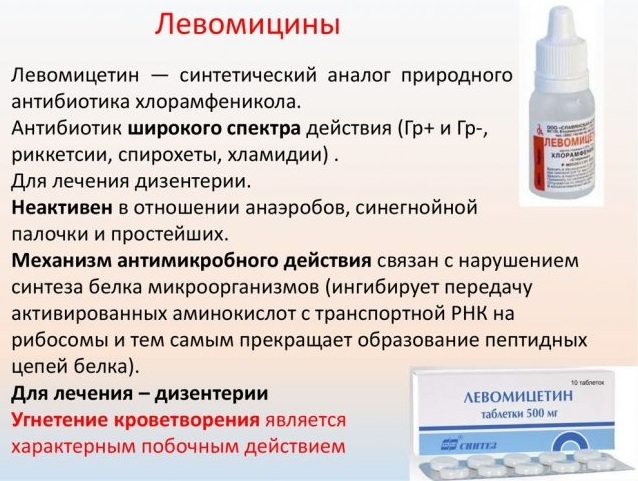
At the same time, the drug is inactive against Pseudomonas aeruginosa of the simplest microorganisms, clostridia and acid-resistant bacteria.
Drops of chloramphenicol are indicated for use if, according to the results of a diagnostic examination, an inflammatory eye disease caused by the following types of infections:
- all types of staphylococcus;
- chlamydia;
- streptococcus;
- enterococcus;
- Escherichia coli and Haemophilus influenzae;
- gonococcus.
The above microorganisms can enter the tissues of the organ of vision along with dirty hands or hematogenous. Determination of the strain of bacterial infection should be performed in the course of laboratory research before the appointment of Levomycetin.
Compound
Drops of Levomycetin for the eyes of a child contain the active substance chloramphenicol. It is a chemical compound that has pronounced antibacterial properties. It was first invented in 1947 by isolating actinomycetes from cultures.
The composition of antibacterial drops contains a synthetic analogue of this substance, which is manufactured at the enterprises of the pharmaceutical and chemical industries. In artificial conditions, chloramphenicol is obtained by a complex synthesis from styrene, which consists of 10 stages.
Liquid chloramphenicol has a high biochemical activity, and is also very toxic to most gram-positive and gram-negative microorganisms.
According to the national legislation of the Russian Federation, chloramphenicol-based drugs are included in the list of essential drugs. This is due to the fact that this substance is capable of destroying such dangerous strains of pathogenic bacteria as spirochete, rickettsia, chlamydia. On the basis of chloramphenicol, medications of a different form of release are made. For example, ointment, tablets, capsules.
In what form is it produced
Levomycetin for the treatment of eyes in children is available in the form of drops. This is a chloramphenicol solution with 0.25% active substance concentration. The drug is poured into plastic bottles with a capacity of 5 or 10 ml, which are additionally packed in a cardboard box. The average cost of a medicine is 75 rubles.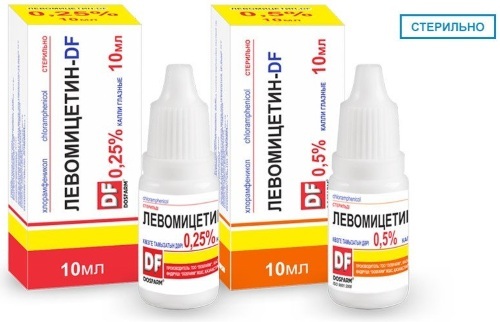
On the shelves of pharmacies, you can also find the drug Levomycetin in the following release forms:
- alcohol solution 0.25% concentration, which is used for external use for the purpose of antiseptic treatment of wounds and ulcerative formations of the skin surface (produced in glass vials with a capacity of 25 ml, and the price of the medication is 45 rub.);
- powder for preparation of injections (packaged in glass bottles of 0.5 g, and the cost of the drug is 80 rubles);
- cream for external use with a concentration of chloramphenicol of at least 1% (produced in aluminum tubes with a capacity of 30 g, and the average price of a medication is 110 rubles);
- white tablets of 250 mg (the average price in pharmacies is 65 rubles).
Drops of Levomycetin have the appearance of a completely transparent liquid with a characteristic chemical smell of the drug. There should be no sediment or signs of its separation into fractions in the vial with the medication.
Pharmodynamics
After drops of Levomycetin fall on the mucous membrane and tissues of the organ of vision, the process of suppressing the bacterial microflora begins, which causes inflammatory damage to the eyes.
The mechanism of the antimicrobial effect is achieved by disrupting the synthesis of protein compounds in the composition of pathogenic microorganisms. Bacteria lose the ability to cell division, their activity and quantity in the composition of tissues decreases, and the patient is on the mend. Drops of Levomycetin have bacteriostatic properties.
A distinctive feature of the drug is that the pathogenic microflora remains sensitive to the active component of the drug, even if it is used for a long time. The resistance and addiction of bacteria to the drug practically does not develop, or it appears relatively slowly.
Provided that the entire therapeutic course is completed without interruption and unauthorized dose reduction, the effect of complete destruction of bacterial microorganisms, elimination of the inflammatory process and full restoration of organ functions vision.
Pharmacokinetics
Levomycetin is an antibacterial agent with a high degree of biochemical activity. The absorption of the basic substance in the tissues of the body reaches 90%.
The connection with plasma protein compounds is from 50 to 60%, and in premature babies who were born prematurely - 32%. After making drops on the surface of the mucous membrane of vision, Levomycetin rapidly penetrates into tissues and body fluids.
The maximum concentration of the active substance of the drops is found in the composition of the blood serum 4-5 hours after the application of the medication. After the end of the metabolic process, the decay products of the antibiotic accumulate in the tissues of the liver and kidneys.
Levomycetin is excreted within 24 hours. About 90% of metabolites are excreted from the body as part of urine, and the main physiological load falls on the tissues of the kidneys and liver.
A distinctive feature of the pharmacokinetic properties of Levomycetin is that the main component of the drug practically not amenable to excretion by hemodialysis, and the disintegration of the drug occurs physiologically in the tissues liver.
Application
For the treatment of infectious eye diseases using Levomycetin, it is necessary to apply antibacterial drops to the surface of the mucous membrane of the eye 1 to 2 times a day. The maximum duration of use of the medication is 4 weeks.
Treatment with Levomycetin should be carried out in an inpatient department under the supervision of a pediatric ophthalmologist. This is due to the high toxicity of the active component - chloramphenicol, as well as the risk of side effects.
In the process of therapy with an antibacterial agent, it is necessary to control the biochemical composition of the child's blood.
Particular attention should be paid to the health of the kidneys and liver, since it is these organs that bear the additional burden of metabolic breakdown of chloramphenicol. Children who are being treated with Levomycetin drops should not take syrups, as well as other medications containing ethanol.
The drug can be used as a main or auxiliary agent for the treatment of the following eye diseases:
- conjunctivitis;
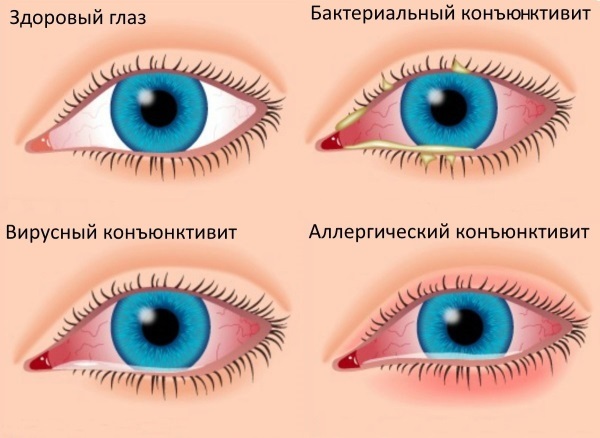
- blepharitis;
- keratitis;
- postoperative and post-traumatic complications associated with bacterial infection of the organ of vision.
The simultaneous combination of this substance and chloramphenicol leads to a disulfiram-like reaction.
This is a pathological condition of the body, which is expressed in a feeling of severe nausea, bouts of vomiting, incessant coughing, tachycardia, shortness of breath, redness of the skin. The final dosage and duration of the therapeutic course should be determined by the pediatric ophthalmologist.
Contraindications
Drops of Levomycetin for eyes (a child may be contraindicated for use by the attending physician) are not used to treat children who suffer from the following diseases or pathological conditions of the body:
- individual intolerance to chloramphenicol, which is expressed in the form of an acute allergic reaction (the appearance of a red rash, itching of the skin surface, bronchial spasm, edema of mucous and epithelial tissues, hives);
- all types of blood diseases that are associated with a change in its biochemical and cellular composition;
- porphyria;
- lack of the enzyme glucose-6-phosphate dehydrogenase;
- chronic renal failure (the use of Levomycetin can provoke a deterioration in the child's well-being and an exacerbation of the disease);
- severe dermatological diseases in the form of eczema, skin lesions by fungal infections, psoriasis;
- liver tissue diseases associated with the gradual destruction of its cellular structure (intoxication or viral hepatitis, malignant neoplasms, cirrhosis, parasitic invasions);
- pathology of the hematopoietic system.
Contraindications to the use of Levomycetin drops are determined by a pediatric ophthalmologist, who must initially examine the child, establish the cause of an eye infection, determine the strain of bacteria and make sure that there are no medical restrictions on use chloramphenicol.
Overdose
Drops of Levomycetin should be used in the dosage determined by the attending physician. Violation of drug doses with the introduction of a large amount of a medicinal solution on the surface of the mucous membrane of the eyes, can lead to a short-term decrease in visual acuity, the inability to focus on the same subject.
Also, the development of the following local reactions is not excluded:
- increased tearing;
- redness of the mucous membrane of the organ of vision;
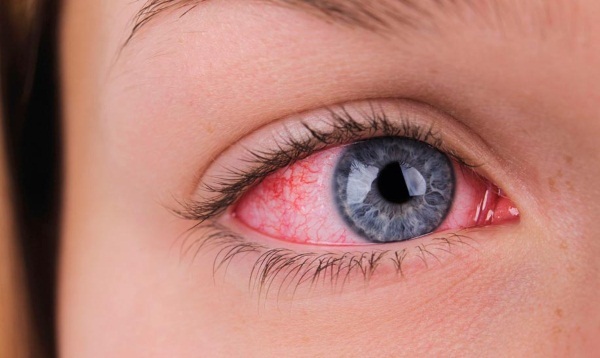
- severe itching of the eyelids, which can be removed only after taking antiallergic drugs;
- discomfort in the eyes, which occurs in response to direct sunlight or bright light;
- the appearance of visual hallucinations;
- edema of epithelial tissues located in the circumference of the eyeball, as well as the appearance of a red rash;
- Pain in the eyes.
Such symptoms indicate the development of an acute allergic reaction. Severe manifestations of an overdose can be expressed in nausea, vomiting, loss of appetite. In case of an overdose, it is necessary to urgently rinse the eyes with running water.
If there is warm boiled water in the room, then it is better to use it. This will avoid secondary infection of the eyes with bacterial microflora. After that, the child should be examined by a pediatric ophthalmologist. In most cases, no special sorbent preparations are required.
Side effects
During the use of Levomycetin in the form of drops, the development of side effects is unlikely. In most cases, they manifest themselves in the form of local dermatoses, urticaria of epithelial tissues located around the organ of vision, itching, visual hallucinations, blurred vision, blurred eyes, headache pain.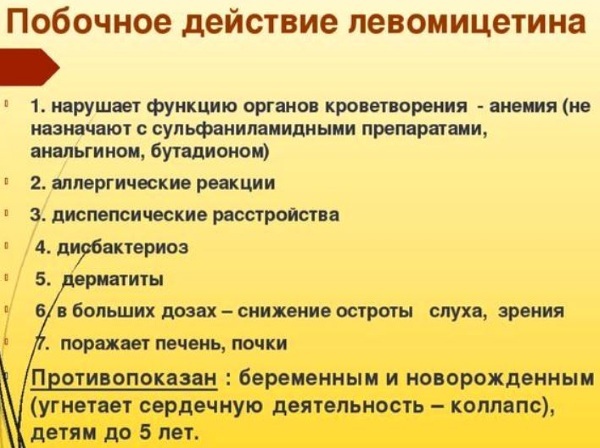
In the first days of using eye drops, the child should be under the supervision of parents and medical personnel. In the event of adverse reactions, further use of the drug should be discontinued immediately. For a faster elimination of this symptomatology, it may be necessary to take antihistamines, which stop the manifestation of allergies.
Drug interactions
Drops of Levomycetin are distinguished by high biochemical activity.
The drug is able to enter into drug interactions with the following substances and medicines:
- Phenobarbital, Rifabutin, and Rifampicin can reduce the concentration of chloramphenicol in the blood serum and accelerate its metabolism in the liver tissues;
- Paracetamol slows down the half-life of chloramphenicol and its excretion from the child's body;
- enhances the effect of drugs of the cyclosporin series (with the simultaneous use of Levomycetin and drugs of this group, it is necessary to control the level of cyclosporin);
- reduces the antibacterial effect of drugs, the active ingredients of which are penicillin and cephalosporin.
The above biochemical properties of the drug must be taken into account during the complex and combined therapy of infectious eye diseases. The simultaneous use of these drugs may not bring a positive therapeutic effect.
Storage conditions and periods
Drops of Levomycetin should be stored in their original cardboard packaging out of direct sunlight at an air temperature not exceeding +25 degrees Celsius. The drug should be kept out of the reach of children.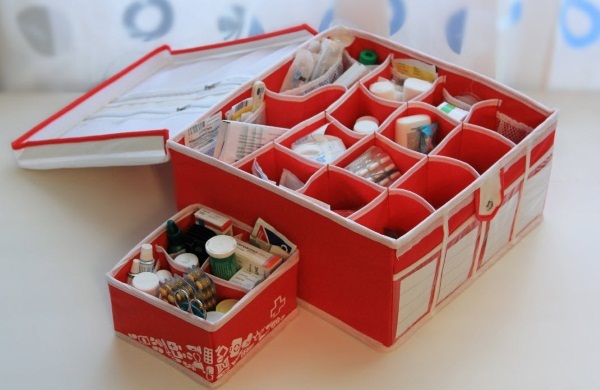
Subject to these storage conditions, the drug does not lose its pharmacological properties for 5 years. After the expiration date, the drug is prohibited for use, and its use can harm the health of the child.
Conditions of dispensing from pharmacies
To purchase a drop of Levomycetin, a prescription from an ophthalmologist is required. With this document, the drug can be bought in retail pharmacy chains.
Analogs
Levomycetin is a drug that has no analogues. All medicines, which contain the active substance chloramphenicol, are produced under the name Levomycetin. Only the pharmacological form of the drug, its area of application, medical indications for the use of the drug, as well as the manufacturer can change.
Drops of Levomycetin for the treatment of infectious eye diseases in a child is a potent an antibacterial agent that is effective against most gram-positive and gram-negative microorganisms. The medication is applied 1-2 times a day with a therapeutic course of up to 4 weeks.
The drug can be used as an independent bacteriostatic agent, or it can be included in the general course of antibiotic therapy.
The high degree of toxicity of the active substance of the drug - chloramphenicol, requires a preliminary examination of the child, as well as careful monitoring by the attending physician. The drug can cause side effects in the form of local allergic reactions.
Article design: Vladimir the Great
Video about the drug Levomycetin
Description and instruction of Levomycetin tablets:



